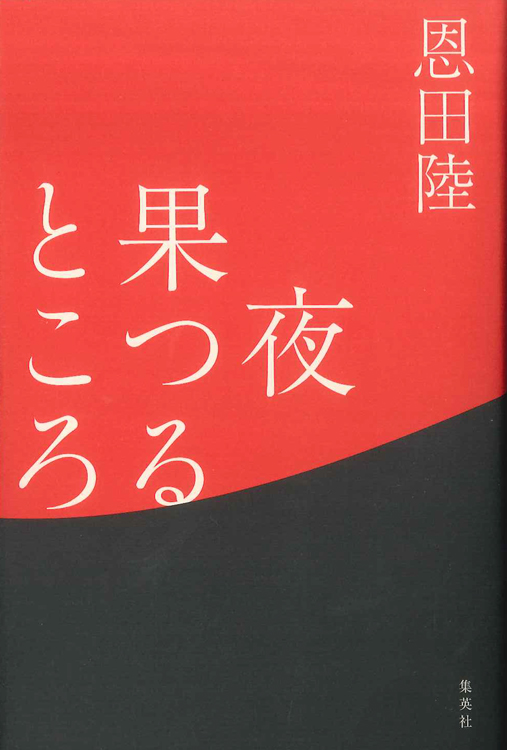[232nd] Michiko Mamuro's Bookshelf "Where the Night Ends" by Riku Onda / Shueisha
Known as the "original charismatic bookseller," DAIKANYAMA TSUTAYA BOOKS, who recommends books in a variety of media including magazines and TV.
In this series, we take a peek into the "bookshelves" in the mind of our most popular concierge.
Please enjoy it along with his comments.
* * * * * * * *
"Where the Night Ends"
Riku Onda/Shueisha
Click on the image to go to the purchase page.
Click on the image to go to the purchase page.
* * * * * * * *
Hello everyone. "Mamuro Michiko's Bookshelf" will be updated on the first, second and third Thursday of July. The fourth Thursday will be a break. Here is the first book of the month!
This book is a novel that appears in "Dull Colored Visions," which was introduced in the 228th issue. It's rare for such a "work within a work" to be released as a real book. Shueisha, great decision. Onda Riku, amazing. To be more specific, aren't you two scared?
After all, the novel "Where the Night Ends" is known for the many disasters it causes. To publish something like this in real life!!!
Of course, as a mystery fan, this is intriguing. A character in "Dull Gray" said the following:
"The film set is like a shrine maiden, like black magic, where you create a certain 'place', prepare a support, and invite what might be called the god of film to be possessed."
You can replace "movies" with "novels." And in my opinion, while he has published a wide variety of works, including mystery, science fiction, horror, fantasy, and youth novels, as well as a mixture of these, everything he writes has the same underground heat: "I want to invite the god of stories."
This warms the hearts of readers as well. Onda's world is not the content of a single work, but a constant, bubbling geothermal heat.
Anyway, this book is a Gothic fantasy tale, a recollection of the childhood of "I", a man who had three mothers.
The mothers, the other women, Bowie, the servants, and the various guests are in a large mansion in the mountains. There is moaning and crying, yelling, and low, flowing singing.
"I" was strictly forbidden to meet customers face to face, but when I bumped into a regular writer, he laughed and compared me to a princess in a fairy tale. When I was seen by an uninvited guest, the man said, "You're so small, yet so beautiful. You'll be able to make a lot of money soon."
Yes, I was a beautiful child.
In "Dull-Colored Visions," it is mentioned that the covers of "Where the Night Ends" are different. They are the same first edition, but if you remove the covers of the two books and place them one on top of the other, there are subtle differences. If they were completely different, you would not even notice. A slight "illusion"-like sensation turns into a "distortion" that covers the whole thing. This is the core of the story of "Where the Night Ends."
Many stories told from a young perspective have a certain exhilaration and creepiness to them because they do not interpret them. Whether they are peeking into the adult world or seeing strange phenomena, children do not think that they are seeing things wrong or that they are strange, but directly experience their longings and fears. They may even have scenes in their heads that they could never have seen or conversations they could never have heard.
The crisis of the weak, a mixture of witnessing, imagination, and delusion, gently shakes the reader. As Onda has written in several essays and novels, we love stories about "will this child survive?"
But before long, you'll be taken aback by the ruthlessness that's so common at this age. There's a memory inside of "me" and a feeling that there's no way I could have done it. The same cry will rise from the reader's heart.
The name of the mansion is "Tsukigaochiru". It can also be read as "Tsukigaochiru". Everyone here has already been, or will be, abandoned by fate. Its spectacular beauty.
If "Dull Colored Visions" is a luxury cruise ship, this book is a small boat going down the river. Let's go with the flow and head for the end of the night. Can we, "I," reach the light?
This book is a novel that appears in "Dull Colored Visions," which was introduced in the 228th issue. It's rare for such a "work within a work" to be released as a real book. Shueisha, great decision. Onda Riku, amazing. To be more specific, aren't you two scared?
After all, the novel "Where the Night Ends" is known for the many disasters it causes. To publish something like this in real life!!!
Of course, as a mystery fan, this is intriguing. A character in "Dull Gray" said the following:
"The film set is like a shrine maiden, like black magic, where you create a certain 'place', prepare a support, and invite what might be called the god of film to be possessed."
You can replace "movies" with "novels." And in my opinion, while he has published a wide variety of works, including mystery, science fiction, horror, fantasy, and youth novels, as well as a mixture of these, everything he writes has the same underground heat: "I want to invite the god of stories."
This warms the hearts of readers as well. Onda's world is not the content of a single work, but a constant, bubbling geothermal heat.
Anyway, this book is a Gothic fantasy tale, a recollection of the childhood of "I", a man who had three mothers.
The mothers, the other women, Bowie, the servants, and the various guests are in a large mansion in the mountains. There is moaning and crying, yelling, and low, flowing singing.
"I" was strictly forbidden to meet customers face to face, but when I bumped into a regular writer, he laughed and compared me to a princess in a fairy tale. When I was seen by an uninvited guest, the man said, "You're so small, yet so beautiful. You'll be able to make a lot of money soon."
Yes, I was a beautiful child.
In "Dull-Colored Visions," it is mentioned that the covers of "Where the Night Ends" are different. They are the same first edition, but if you remove the covers of the two books and place them one on top of the other, there are subtle differences. If they were completely different, you would not even notice. A slight "illusion"-like sensation turns into a "distortion" that covers the whole thing. This is the core of the story of "Where the Night Ends."
Many stories told from a young perspective have a certain exhilaration and creepiness to them because they do not interpret them. Whether they are peeking into the adult world or seeing strange phenomena, children do not think that they are seeing things wrong or that they are strange, but directly experience their longings and fears. They may even have scenes in their heads that they could never have seen or conversations they could never have heard.
The crisis of the weak, a mixture of witnessing, imagination, and delusion, gently shakes the reader. As Onda has written in several essays and novels, we love stories about "will this child survive?"
But before long, you'll be taken aback by the ruthlessness that's so common at this age. There's a memory inside of "me" and a feeling that there's no way I could have done it. The same cry will rise from the reader's heart.
The name of the mansion is "Tsukigaochiru". It can also be read as "Tsukigaochiru". Everyone here has already been, or will be, abandoned by fate. Its spectacular beauty.
If "Dull Colored Visions" is a luxury cruise ship, this book is a small boat going down the river. Let's go with the flow and head for the end of the night. Can we, "I," reach the light?
* * * * * * * *
(Redirects to Yahoo! Shopping)

DAIKANYAMA TSUTAYA BOOKS Literature Concierge
Michiko Mamuro
【profile】
"The original charismatic bookseller" who recommends books in various media such as magazines and TV. She has a serial in the magazine "Fujingaho" and Asahi Shimbun Digital's "Honya no Hon". She is also active as a book critic, and her paperback reviews include "The Pale Horse" (Agatha Christie/Hayakawa Christie Bunko), "Motherhood" (Minato Kanae/Shincho Bunko), "The Snake Moon" (Sakuragi Shino/Futaba Bunko), and "Staph" (Michio Shusuke/Bunshun Bunko).
























